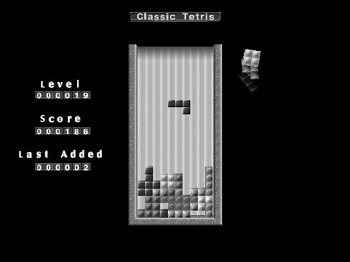The Technology
Another similarity between Tetris and classic arcade games is that none of those games relied on their technology to impress players. For CAGs, the graphics the arcade machines in the early 80s could produce were so lackluster compared to what players would find in other media, such as movies or television, that players had to be drawn in by something else. As a result, the gameplay had to be truly captivating for these games to survive. Despite the fact that much more sophisticated graphics were available by the time Tetris was released in the West in the late 80s, the game did not need fancier graphics and stuck to a very simple 2D implementation. Tetris s gameplay is so strong that it does not matter how technologically simple its implementation may be, the game is still wildly entertaining.
The implementation of Tetris is so simple that many aspiring game programmers start out by making a Tetris clone. Indeed, numerous companies have attempted to add fancy graphical effects to the game, including making it 3D. The first of these was probably Welltris , a sequel of sorts to Tetris , designed by Pajitnov. In Welltris , a 3D well takes the place of the Tetris box. Tetris -style pieces (though not always of four blocks) fall down along the sides of the well and must be lined up into rows on the bottom. The gameplay was considerably more complex without being particularly more fun or challenging. As a result, players were uninterested, and went back to the simplicity of the original. Many subsequent Tetris knockoffs attempted to make improvements on the original, either through fancy effects or special pieces of various sorts. None of these attempts were particularly successful, and players continued to want to return to the original.
The attempts to add technological sophistication to Tetris failed, not just commercially but also artistically. The enhanced technology added to these knockoff products was actually detrimental to the original game design, polluting its purity and making the game lose its elegance and fun in the process. Of course, the moral to the story is that enhanced technology is not necessarily beneficial to a given game, and game designers must be wary when the whiz-bang engine effects start to get in the way of what makes the game entertaining in the first place.
While Tetris may have not needed much in the way of computer technology to function, it is worth pointing out that there could be no Tetris without a computer. Tetris is not a game adapted from a pen and paper or board game, but rather something that only can exist in a world carefully controlled and governed by a computer. As mentioned previously, Pajitnov is said to have drawn his inspiration from the non-computer puzzle game pentomino. In adapting it to the computer, Pajitnov changed it into a form that could exist only on a computer. The descending of the pieces from the top of the screen at a steady rate, the way they can interact with the pieces already at the bottom of the screen, and the random way in which pieces become available to players are all operations only a computer program could provide while still allowing for an entertaining experience for players. These are all tasks the computer performs expertly, and it was brilliant of Pajitnov to think to add them to his game.

Tetris has a very limited artificial intelligence that randomly picks the blocks which fall into the play-field. Despite its simplicity, this AI provides the perfect challenge for the player.
EAN: 2147483647
Pages: 189